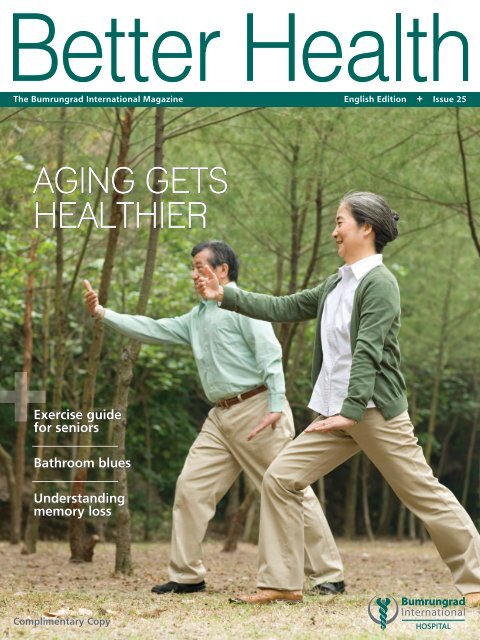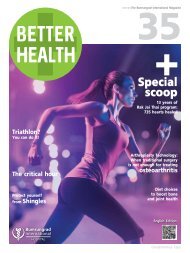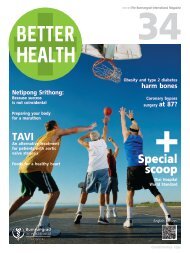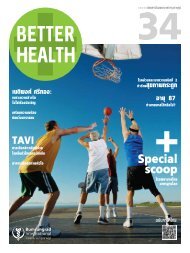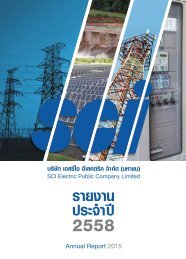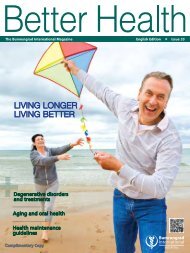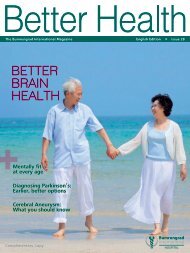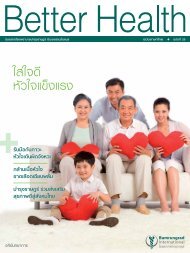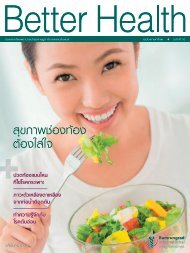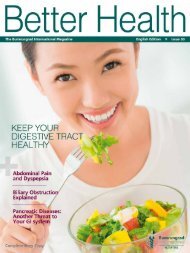Better Health 25 Eng
The magazine for patients and friends of Bumrungrad International Hospital, Thailand.
The magazine for patients and friends of Bumrungrad International Hospital, Thailand.
- TAGS
- bumrungrad
- hospital
- thailand
You also want an ePaper? Increase the reach of your titles
YUMPU automatically turns print PDFs into web optimized ePapers that Google loves.
p2 Ad Heathy Max
W e l c o m e<br />
Welcome to<br />
, the magazine <br />
for patients and friends of Bumrungrad <br />
International Hospital.<br />
The world’s population is getting older. <br />
Thailand’s seniors now account for over ten <br />
percent of the Thai population; by 2027, that <br />
figure is likely to reach 20 percent. <br />
This issue of<br />
focuses special <br />
attention on the important health issues affecting<br />
senior adults. While some may equate getting <br />
older with a decline in health, many seniors are<br />
living healthy, active lives well into their 80s and 90s<br />
thanks to good nutrition and exercise habits and<br />
getting recommended check-ups and screenings.<br />
Beginning on page 4, we look at age-associated<br />
diseases and how to prevent them through <br />
healthier diets and regular exercise. Exercise <br />
is one of the best things we can do for our <br />
health as we age; the feature on page 8 makes <br />
a compelling case for exercise’s numerous <br />
health benefits that are just as powerful for <br />
seniors as everyone else. <br />
Many people worry their senior years will<br />
be marked by declining memory and mental<br />
function. Everyone forgets things sometimes; but<br />
more than the occasional lapse may point to a <br />
more serious condition such as dementia or<br />
Alzheimer’s disease. On page 15 we look closely<br />
at these and other brain conditions and offer<br />
advice on how to lessen aging’s impact on<br />
brain health. <br />
As always, we welcome your feedback, ideas<br />
and comments about<br />
. Please feel<br />
free to e-mail us at betterhealth@bumrungrad.com.<br />
We look forward to hearing from you, and <br />
here’s wishing you better health.<br />
<br />
<br />
<br />
<br />
Dr. Num Tanthuwanit<br />
Medical Director &<br />
Contributing Editor<br />
C o n t e n t s<br />
4 <strong>Health</strong>y aging<br />
Aging without disease<br />
8 Active at every age<br />
Exercise is the key to healthier<br />
retirement years<br />
12 M.D. Focus<br />
Get to know our doctors<br />
15 Aging brain<br />
Normal memory lapse or a sign of<br />
something serious?<br />
18 Q & A<br />
20 <strong>Health</strong> Briefs<br />
22 News from Bumrungrad International<br />
4 15 20<br />
<strong>Better</strong> <strong>Health</strong> magazine is published by Bumrungrad Hospital Public Company Limited and is produced <br />
for Bumrungrad Hospital Public Company Limited by Oakins and Stone Limited, 16 Asoke Court,<br />
Suite 2-A, Sukhumvit 21 Road (Asoke), Klongtoey-nua, Wattana, Bangkok 10110. Tel: +66 (0) 2261 1211<br />
Fax: +66 (0) 2261 1213. www.oakinsandstone.com<br />
No part of this magazine may be reproduced without the written permission of Bumrungrad Hospital <br />
Public Company Limited. 2012 by Bumrungrad Hospital Public Company Limited. All rights reserved. <br />
Publication of advertisements or sponsorships shall not constitute an endorsement by Bumrungrad <br />
Hospital Public Company Limited of the products or services promoted, of the company or organization,<br />
nor of the claims made.<br />
Telephone:<br />
Facsimile:<br />
Out-patient<br />
appointment:<br />
Website:<br />
66 (0) 2667 1000<br />
66 (0) 2667 <strong>25</strong><strong>25</strong><br />
66 (0) 2667 1555<br />
www.bumrungrad.com
HEALTHY AGING<br />
Aging without disease<br />
<strong>Health</strong>ier senior years depend on preventing <br />
age-associated diseases.<br />
The world keeps getting older. Demographics and <br />
longevity gains have expanded the size of the <br />
senior population in most parts of the world,<br />
including Thailand. Thailand’s senior population, those<br />
aged 60 or older, has surpassed 8 million – about 11<br />
percent of the total population – an increase of almost<br />
one million since 1997. <br />
The population has been “graying” in large part<br />
because people are living longer; a study by the Institute<br />
for Population and Social Research at Thailand’s Mahidol<br />
University reported the average life expectancy<br />
for Thai children born in 2010 is 73 years – 13 years<br />
longer compared to children born in 1975. And it’s<br />
expected to increase further to nearly 80 years<br />
within another decade. <br />
The gift of long life is more precious when<br />
those extra years are lived in good health. But<br />
many still spend their golden years confronting<br />
one health problem after another. For expert<br />
insight on healthier aging,<br />
turned to<br />
Dr. Lily Chaisompong, a Bumrungrad specialist <br />
in geriatric health with many years of experience<br />
helping patients enjoy healthier, higher quality<br />
senior years. <br />
<br />
Beyond the numbers<br />
In chronological terms, 60 is the commonly<br />
accepted age when an adult becomes a senior.<br />
But from a medical perspective, chronological age<br />
doesn’t tell the full story of an individual’s overall<br />
health or level of physical fitness. “Each person<br />
ages at his or her own pace, so chronological age<br />
alone doesn’t reveal a lot,” says Dr. Lily. “The body<br />
begins its decline around the age of 40. While many<br />
factors affect the aging process, it’s clear that taking<br />
better care of one’s health slows the rate of decline.” <br />
Some of the most serious health problems pose greater<br />
threats as we age. These health problems related to age<br />
fall into one of two categories. Age-associated conditions,<br />
such as cardiovascular disease, increase in frequency<br />
with age. The other category, age-specific diseases,<br />
includes conditions such as osteoporosis and Alzheimer's<br />
disease that affect only older age groups. (A related<br />
article can be found on page 15). <br />
Vascular threats<br />
Vascular-related disorders such as diabetes, high <br />
blood pressure and stroke are not directly associated<br />
with aging. They typically affect people whose prolonged,<br />
unhealthy habits – especially poor diets and lack of<br />
exercise – lead to high blood sugar and high cholesterol,<br />
key risk factors for vascular diseases. Reducing these
isks can usually be accomplished through<br />
lifestyle modification, i.e. adopting healthier<br />
diet and exercise habits. Dr. Lily cautions<br />
seniors to avoid extreme changes, such<br />
as totally cutting out dietary fat or meat<br />
from one’s diet. Our bodies need fat; foods<br />
including meat are important sources of<br />
energy, protein and nutrients that help<br />
repair damage caused by the aging process.<br />
“Many seniors make the mistake of avoiding<br />
high-protein foods as they assume their bodies<br />
are too old to chew and digest meat,” Dr. Lily<br />
explains. “In actual fact, protein is important<br />
to counter loss of muscle mass and brain shrink-<br />
age. Without enough protein, they’re at greater<br />
risk of seeing their health deteriorate more quickly.” <br />
For seniors already diagnosed with a vascular <br />
disease, fish and nuts are healthier protein sources <br />
than beef, pork or chicken. Fiber from nuts promotes<br />
the removal of bodily waste through the excretory <br />
system. It also facilitates the release of cholesterol and<br />
helps control blood sugar. Fish containing omega-3 <br />
fatty acids are one of the best sources of the so-called<br />
“good fats” believed to help lower blood cholesterol. <br />
Osteoporosis dangers<br />
The impact of the aging process is marked by a decline<br />
in bone density, greater risk of bone fractures, and<br />
eventually having to deal with osteoporosis. Dr. Lily <br />
cautions women to be especially watchful for potential<br />
bone threats as their risk for osteoporosis is significantly<br />
higher than men. “Women naturally have thinner <br />
bones than men,” notes Dr. Lily. “At the onset of <br />
menopause, a woman’s body abruptly stops producing<br />
the sex hormones which were helping maintain <br />
stronger bones; the abrupt end to hormone production<br />
accelerates the decline in bone density. For men, <br />
osteoporosis poses less of a threat because the decline<br />
in male sex hormones happens gradually – and some<br />
men actually don’t suffer any decline.” <br />
Osteoporosis is a disease which gradually worsens <br />
<br />
“<br />
Managing and treating<br />
age-associated diseases<br />
depends largely on patients<br />
taking an active role in<br />
managing their health by<br />
making healthier lifestyle<br />
choices.<br />
”<br />
Dr. Lily Chaisompong<br />
over the course of many years. It progresses quietly; <br />
symptoms usually don’t appear until years later. <br />
Osteoporosis tends to be diagnosed after significant <br />
decline in a patient’s bone density or, in some cases,<br />
after a serious fracture-causing fall. Adopting <br />
preventive measures earlier in life is one of the best <br />
ways to reduce your risk of a future osteoporosis <br />
diagnosis and for limiting the condition’s severity. <br />
Calcium plays a critical role in keeping bones <br />
healthy and strong. Adults should take in about <br />
1,000 mg of calcium a day. In Thailand, most people <br />
don’t get enough calcium from their diet, even when <br />
including calcium-rich foods like fish, nuts, tofu and <br />
leafy green vegetables. That’s because most Thais, <br />
especially seniors, don’t consume enough milk and <br />
other dairy products that are rich in calcium. <br />
Bladder control ailments differ by gender <br />
H<br />
ealth issues affecting bladder control are more prevalent in older adults. <br />
But the chief complaints depend on gender; the problems of senior men<br />
tend to be the opposite of senior women.<br />
<br />
Prostate problems<br />
Men are most likely to experience difficulty passing<br />
urine, with prostate enlargement the most common<br />
cause of the problem. When the prostate gland becomes<br />
enlarged, it presses against the urethra, making it more<br />
difficult – or, in severe cases, impossible – for urine <br />
to pass through the urethra. <br />
For men with milder cases, doctors typically prescribe<br />
anti-spastic medication which reduces the size of the<br />
prostate to the point where symptoms dissipate and<br />
normal bladder function is restored. In more serious<br />
cases, surgery to remove a portion of the prostate may<br />
be recommended. <br />
<br />
Female incontinence<br />
Incontinence is the most pre-<br />
valent bladder-related health <br />
problem for senior women. It’s <br />
typically caused by pelvic organ <br />
prolapse, a condition that makes <br />
it difficult to prevent urine from <br />
leaking through the urethra. <br />
Exercising the pelvic muscles can help relieve the problem;<br />
contracting the pelvic floor muscles 100 times a day will tighten<br />
pelvic muscles and reduce incontinence. In more serious cases, <br />
your doctor may recommend surgical treatment to correct the<br />
problem.
Calcium supplements can offset some of the shortfall.<br />
But they can be difficult for the body to absorb, especially<br />
calcium carbonate; its absorption rate can be as low <br />
as 40 percent. One way to compensate is by dividing<br />
the supplement into smaller doses of 500-600 mg, <br />
and take with meals for better absorption. <br />
<br />
Drug interaction dangers<br />
As many seniors know from personal experience, dealing<br />
with age-related health problems usually means taking<br />
more medications. Prescriptions can come from multiple<br />
sources, with different doctors treating different health<br />
problems, additional advice from caring friends and<br />
relatives on top of one's own research and knowledge. <br />
Besides medicines prescribed by doctors, many seniors<br />
also take various vitamins, supplements and/or traditional<br />
Thai and Chinese remedies. <br />
Unfortunately, many don’t fully understand the potential<br />
dangers of drug interactions occurring when certain<br />
medications are taken together. Dr. Lily notes that, in theory,<br />
medication should be taken only when necessary, and<br />
all things being equal, as seldom as possible. “Seniors<br />
should consult a specialist, either a doctor or pharmacist,<br />
for advice on a medication’s necessity and potential drug<br />
interactions,” she explains. “And at every consultation,<br />
inform your doctor or pharmacist of any medications <br />
you’re currently taking, to avoid possible duplication.”<br />
<br />
NSAIDs caution<br />
Seniors need to be cautious with certain drugs such <br />
as non-steroidal anti-inflammatory drugs (NSAIDs).<br />
NSAIDs including aspirin and ibuprofen can cause serious<br />
side effects, especially perforation of the stomach lining,<br />
kidney problems and high blood pressure. These drugs<br />
should only be taken when necessary under a doctor’s<br />
direction, and prolonged use should be avoided. <br />
Caution should also be taken with cold medicines,<br />
antihistamines and certain types of sleep aids. These<br />
medicines affect the central nervous system and, especially<br />
if taken in too large a dose, can cause blurred vision and<br />
drowsiness, potentially leading to an accident or dangerous<br />
fall. Strong sleeping medications such as diazepam interact<br />
with chemicals in the brain and are known to cause <br />
depression when taken for an extended period of time. <br />
Managing and treating age-associated diseases depends<br />
largely on patients taking an active role in managing<br />
their health. That includes making healthier lifestyle<br />
choices when it comes to nutrition and exercise. Good<br />
mental and emotional health is also important in dealing<br />
with symptoms and managing chronic illnesses. And a<br />
strong support system can make a significant difference.<br />
As Dr. Lily says, “the caring and support of the family’s<br />
younger generations and close friends truly helps seniors<br />
live happier, healthier lives.”<br />
p6 Ad BBL
p7 Ad Roche
ACTIVE AT EVERY AGE<br />
Exercise is the key to<br />
healthier retirement years<br />
Seniors who exercise can look forward to the rewards of<br />
active living: longer, healthier lives and fewer threats<br />
of serious illness.<br />
Retirement is supposed to be the beginning of a more <br />
carefree stage of life, as the responsibilities of career <br />
and raising children give way to freedom and free time<br />
to pursue favorite hobbies, travel to new places and devotion to<br />
grandchildren. But retirement reality often turns out quite<br />
different; many seniors spend more time with their doctors than <br />
their grandkids as they deal with frequent health problems, <br />
bouts of depression or declining cognitive abilities. <br />
While most people<br />
have gotten the message<br />
about the numerous<br />
health benefits of<br />
regular exercise, not<br />
everyone takes the<br />
message seriously<br />
enough to give up their<br />
sedentary ways.<br />
Seniors have as much<br />
to gain from exercise<br />
as any age group, but<br />
they can be tough to<br />
convince, and they have<br />
more reasons and<br />
excuses, legitimate and<br />
otherwise, for not exercising – difficulty walking, feeling<br />
tired, stiffness of the joints, aches and pains, to name a few.<br />
<br />
Staying mobile <br />
According to Dr. Suthee Siriwechdaruk, a board certified<br />
specialist in physical medicine and rehabilitation at<br />
Bumrungrad, exercise is a proven way to strengthen disease<br />
prevention, promote healing and slow or reverse damage <br />
brought on by the aging process and other causes. <br />
Though they may have the most to gain from physical<br />
activity, seniors often require more of a push to exercise<br />
as their physical condition may be less than optimal.<br />
“Senior adults may need some encouragement to become <br />
motivated to start exercising,” says Dr. Suthee. “Helping <br />
them understand the benefits of exercise and the risks of <br />
inactivity is enough motivation for many seniors to make <br />
the difference. Having reduced mobility doesn’t mean you <br />
can’t exercise – it’s a good reminder of the need to exercise <br />
so you can pursue a happier, healthier senior life with the <br />
freedom to go where you want and take part in activities <br />
that make you happy.” <br />
Our body’s mobility <br />
during our senior years <br />
“<br />
Seniors should include <br />
exercises targeting <br />
different areas of the <br />
body, and be sure their <br />
exercise routine is ‘slow <br />
but consistent’ and ‘low<br />
resistance’.”<br />
Dr. Suthee Siriwechdaruk<br />
can be affected by a <br />
number of factors: the <br />
aging process; chronic <br />
diseases such as diabetes <br />
that lead to artery damage, <br />
impaired vision, inflam-<br />
mation of bones and joints; <br />
muscle weakness or <br />
muscle atrophy due to <br />
nutritional deficiencies <br />
and lack of exercise; and <br />
balance and coordination <br />
problems including <br />
feinting spells, dizziness <br />
and disorientation that are more likely to affect stroke victims <br />
and those with Parkinson’s or other diseases. <br />
Dr. Suthee stresses that exercise should be considered<br />
a necessity instead of something optional. “Exercise is a <br />
must because it provides so many health benefits,” he says. <br />
“For seniors, exercise increases joint mobility, builds <br />
muscle strength, improves balance and coordination, and <br />
boosts heart and lung function. Seniors with joint stiffness <br />
can quickly see results from specific joint exercises. Regular <br />
aerobic exercise helps diabetes patients burn calories more <br />
efficiently and lowers the amount of sugar and fat in the <br />
blood. Some diabetic seniors achieve such dramatic results <br />
from exercise that their disease can be managed without <br />
the need for medication.”
Senior-suitable exercises<br />
The right types of exercise for younger adults aren’t<br />
necessarily appropriate for seniors, especially those being<br />
treated for certain medical conditions. “It’s important that<br />
seniors avoid high-resistance and high-intensity exercises,”<br />
Dr. Suthee advises. “I always recommend my senior patients<br />
include exercises targeting different areas of the body, and<br />
be sure their exercise routine is ‘slow but consistent’ and<br />
‘low resistance’.” <br />
Following are some of the best, most comprehensive<br />
exercises to boost senior body performance and improve<br />
overall health and fitness: <br />
Increased joint mobility. Range-of-motion exercises <br />
can be performed by moving each joint through its full <br />
range of motion. For example, for shoulder mobility, <br />
slowly raise one arm above the head as high as possible; <br />
repeat five to ten times for each shoulder. <br />
Stronger muscles. Resistance training strengthens the <br />
core muscles involved in body movement. These include <br />
leg, hip and back muscles. Light weightlifting, push-ups <br />
done against a wall, and hand- and leg-raisers are all <br />
effective muscle builders for seniors. <br />
Exercise exertion: Is your workout too intense?<br />
Exercise is fundamental to healthier living. But pushing yourself too hard or for too long can turn a good thing <br />
into something harmful, especially for senior adults. One way to measure your level of exercise exertion is to use<br />
the Borg Rating of Perceived Exertion (RPE). The Borg Scale assigns a numerical value from 6 to 20, as detailed<br />
below, based on the physical sensations a person feels during exercise.<br />
Perceived<br />
Exertion<br />
Score<br />
Exercise intensity Physical sensations Target Heart Rate<br />
6-7<br />
8-9<br />
10-11<br />
No exertion at all<br />
Very light exertion<br />
Light exertion<br />
How you feel when lying in bed, watching<br />
TV, or relaxing in a comfortable chair.<br />
Little or no effort. <br />
60% of maximum heart rate<br />
12-13 Moderate/Medium exertion Feels like you can exercise for hours, easy<br />
to breathe and to speak. <br />
14-15 Hard / Heavy exertion Feels energetic enough to exercise for hours,<br />
breathes heavily, can only carry on brief<br />
conversation. <br />
16-17 Very strenuous exertion Discomfort, very difficult to maintain exercise<br />
intensity, barely able to breathe or speak. <br />
60% of maximum heart rate<br />
70% of maximum heart rate <br />
80% of maximum heart rate <br />
18-20 Extremely hard to<br />
maximum exertion <br />
Feels almost impossible to keep exercising,<br />
feels completely out of breath. You are exercising<br />
dangerously hard.<br />
90% of maximum heart rate<br />
DANGER! DO NOT EXERCISE AT<br />
THIS LEVEL OF INTENSITY!<br />
REMINDER: For seniors planning to check their exercise intensity using the Borg Scale, it’s<br />
important that workout intensity be maintained within the “Moderate/Medium exertion” or<br />
“Hard/Heavy exertion” ranges, i.e. within a rating range of 12 to 15.
<strong>Better</strong> flexibility and balance. Exercising an individual <br />
body part through its full range of motion helps stretch <br />
muscles. At the same time, the shifting of weight forward <br />
and back improves balance, a benefit that reduces the <br />
risk of falls, injuries and muscle pain. Yoga and tai chi <br />
are two of the best basic movement exercises. <br />
Improved heart and lung function. Aerobic exercise is <br />
one of the best ways for seniors to improve the function <br />
of their heart and lungs. For maximum results, increase <br />
the intensity level of each workout gradually until you <br />
reach your target heart rate (THR). For seniors, the target <br />
heart rate ranges from 60 to 70 percent of one’s maximum <br />
heart rate, a level that is lower than the THR for younger <br />
adults. During exercise, try to maintain your THR for <br />
about 15 minutes, and include aerobic workouts three <br />
times each week, or about every other day. <br />
“ Having reduced mobility doesn’t<br />
mean you can’t exercise–it’s a <br />
good reminder of the need to <br />
exercise so you can pursue a <br />
happier, healthier senior life.”<br />
Target heart rate<br />
= Maximum heart <br />
rate x 60% or 70%<br />
Maximum heart rate = 220 – age<br />
“An optimal exercise program encompasses these four<br />
categories, giving seniors a full range of benefits to health<br />
and physical fitness,” notes Dr. Suthee.<br />
Limited-mobility exercises <br />
Limited physical mobility doesn’t preclude most seniors<br />
from exercising; there are plenty of ways to achieve better<br />
health by exercising while seated or lying down. Lessstrenuous<br />
exercise is always better than no exercise at all.<br />
Seniors still have a great deal of influence over their postretirement<br />
health and happiness, beginning with a conscious<br />
choice to start living more active lives.<br />
Exercise made safer<br />
Many seniors worry about exercise jeopardizing <br />
their safety and increasing their risk for injuries<br />
and accidents. Whatever one’s age, there’s a right<br />
way to exercise and a wrong way. Exercising the wrong<br />
way causes painful injuries and potential health problems.<br />
Before starting any exercise program, be sure to follow<br />
these recommendations: <br />
Consult your doctor to confirm that it’s safe to start <br />
exercising; your doctor can recommend specific exercises <br />
best suited to your individual situation while ruling out <br />
the presence of any medical problems that may be <br />
aggravated by exercise. <br />
Build intensity gradually, starting with simple, short <br />
exercises that gradually increase endurance until your <br />
body can tolerate a 15- to 30-minute workout.<br />
Choose proper shoes and wear comfortable but not <br />
overly-loose clothing. <br />
Exercise in a safe environment; the floor should be flat <br />
and firm, and room temperature should be moderate, <br />
neither too hot nor too cold. <br />
10<br />
<br />
<br />
Choose exercises that you find enjoyable and that suit <br />
your physical fitness level. Early on, avoid resistance <br />
exercises in favor of low-impact activities like walking, <br />
cycling and swimming.<br />
Keep breathing normally; holding your breath or speeding <br />
up your breathing increases peripheral vascular resistance, <br />
which forces the heart to work harder and puts you at <br />
risk of high blood pressure.<br />
Allow sufficient recovery time between workouts. Consider <br />
switching to lighter exercises until muscle soreness subsides. <br />
Before beginning each workout, always warm up for about <br />
ten minutes to stretch your muscles. And don’t end your <br />
workout without cooling down for five to ten minutes. This <br />
reduces the risk of dizziness and fainting while allowing <br />
blood flow to gradually return to its normal rate. <br />
Avoid working out when you’re feeling tired. And it’s a good <br />
idea to end a workout if you feel overly tired, such as when <br />
breathing heavily makes it difficult to speak normally. <br />
Stop your workout and get medical help if you experience <br />
shortness of breath, chest pain or dizziness.
p11 Ad Modernform
M.D. FOCUS<br />
Get to know our doctors<br />
Meet four Bumrungrad physicians as they share their thoughts on <br />
a range of health care topics.<br />
Providing the highest standards of patient care requires a hospital-wide commitment and <br />
professional expertise. Bumrungrad’s medical staff includes over 900 world class doctors <br />
of the highest caliber, with outstanding professional credentials and advanced training <br />
across the full spectrum of medical sub-specialties.<br />
Dr. Ketchai Suavansri Neurologist<br />
After graduating from Mahidol University’s Faculty of Neurology, Dr. Ketchai began<br />
his medical practice as the sole neurologist in the province of Samut Sakhon. He<br />
gained a wealth of practical experience while fulfilling his tuition waiver commitment.<br />
Dr. Ketchai later joined the Prasat Neurological Institute and eventually headed<br />
to the US to continue his medical training in Alzheimer’s disease.<br />
Q: In your experience,<br />
what aspect of your work<br />
has been the most<br />
challenging? <br />
A: As a doctor in the<br />
suburbs, it can be difficult<br />
to correct people’s misconceptions<br />
and false beliefs<br />
about medicine. I once had to deal with a patient whose<br />
paralysis got better after a rinsing with “magic” water.<br />
Despite my attempts to show that paralysis can sometimes<br />
heal by itself, word quickly spread about the wonders of<br />
magic water. <br />
Dealing with patients who brew their own home-made<br />
medicine poses a real challenge. Sometimes the home<br />
brew contains steroids, giving the patient the impression<br />
they’re feeling better at first, and the serious side effects<br />
only crop up later. There is still much to be done to change<br />
these mistaken beliefs. <br />
Q: What made you decide to join the medical team<br />
at Bumrungrad?<br />
A: Although Bumrungrad operates as a private hospital,<br />
the management doesn’t focus solely on the business side.<br />
The hospital has a good academic atmosphere that<br />
encourages learning and collaboration, and there is a <br />
strong emphasis on staying true to medical ethics. I feel <br />
proud to be a part of the team here.<br />
Dr. Tanawat Jirakulaporn Hematologist and oncologist<br />
While studying at Washington University in the US, Dr. Tanawat had the<br />
opportunity to take part an important research in the field of hematology<br />
and oncology. That spurred him to expand his knowledge and gain experience<br />
treating patients in this field, and he went on to earn a number of board<br />
certifications from international institutes.<br />
Q: Are there cases that you find most memorable? <br />
A: I once had a patient from Ethiopia who had been<br />
diagnosed with stomach cancer by another hospital.<br />
After we ran some tests on his condition, we discovered<br />
he was actually suffering from a rare disease called myeloid<br />
sarcoma, where leukemia cells combine together to form<br />
a solid mass. <br />
Preparing for the treatment was quite frantic, but<br />
there was no choice but to rush because of leukemia’s<br />
fast-developing nature. There are cases like this from<br />
time to time, where the original diagnosis is not correct<br />
and where you really see how having fully competent<br />
medical staff and advanced technology makes a difference<br />
in producing an accurate<br />
diagnosis. <br />
Q: What challenges <br />
you the most in your<br />
work in oncology? <br />
A: It is always difficult<br />
when a patient’s cancer<br />
is not treatable and the<br />
prognosis is terminal. We oncologists, need not only to<br />
provide end-of-life care for patients but also to assist<br />
families and loved ones. It is a difficult time for everyone<br />
involved, and we have a duty to alleviate as much of the<br />
pain and grief as possible.<br />
12
Dr. Suwatchai Pornratanarangsi Cardiologist<br />
More than ten years’ teaching at one of Thailand’s leading medical institutions<br />
helped establish Dr. Suwatchai as one of the Kingdom’s leading authorities in cardiology.<br />
He also earned certification in interventional cardiology at New Zealand’s<br />
Auckland University.<br />
Q: What made you<br />
decide to become a<br />
cardiologist?<br />
A: Back when I was a<br />
medical student, my grand-<br />
mother suffered an acute<br />
myocardial infarction.<br />
Despite my newly-aquired<br />
medical knowledge, there<br />
was nothing I could do but<br />
stand and watch. That<br />
sealed my decision to become a cardiologist; I didn’t want<br />
to feel that powerlessness again.<br />
Q: What types of cases leave the most lasting <br />
impression? <br />
A: I once met a patient suffering terribly from advanced<br />
cardiovascular disease. Before coming to see me, several<br />
hospitals had told him they could do nothing to help.<br />
My diagnosis confirmed that treating him would be quite<br />
risky, and that he might live longer by skipping treatment. <br />
But the patient couldn’t bear the symptoms and asked<br />
to proceed with the treatment anyway. It was very difficult<br />
indeed, but in the end it was successful. As a smile returned<br />
to the patient’s face, I felt so proud that I was able to help<br />
give him a new lease on life. <br />
Q: What interests you most about interventional <br />
cardiology?<br />
A: I’m very intrigued with how the procedure involving<br />
catheterization to restore narrowed coronary arteries <br />
may also have applications for other blood vessels in <br />
the brain, kidney or legs. Being well-versed in all the <br />
body’s veins and arteries gives me the opportunity to <br />
collaborate with other specialists, and I get a fuller <br />
picture of each patient’s overall health. <br />
<br />
Dr. Yot Navalitloha Neurosurgeon<br />
Dr. Yot graduated from the Faculty of Neurosurgery at Chulalongkorn University<br />
before heading to the US for specialized study in brain and spine medicine. His<br />
advanced training and years of practical experience are put to good use in the<br />
complex field of neurosurgery.<br />
Q: What is the most challenging aspect of being a<br />
neurosurgeon?<br />
A: I’ve found that the most challenging part of neurosurgery<br />
comes when deciding whether or not to proceed with<br />
surgery. In cases where a patient’s tumor is in contact<br />
or very near a critical area of the brain, attempting a<br />
complete removal may risk impairing the patient or, in the<br />
most serious cases, the patient may not make it through.<br />
It’s vital that the neurosurgeon be able to judge whether<br />
surgery will successfully remove the tumor or if other,<br />
safer methods such as radiation therapy or chemotherapy<br />
should be performed instead. <br />
Q: What types of cases leave the most lasting<br />
impressions? <br />
A: One of the most vivid cases involved a woman during<br />
her eighth month of pregnancy. After she fainted, we<br />
discovered she had a large brain tumor that required<br />
immediate surgery.<br />
We couldn’t operate with her lying on her back because<br />
the baby’s weight would prevent proper blood flow. So we<br />
had no choice but to operate with her lying on her side.<br />
The surgery was successful,<br />
and we safely delivered the<br />
baby the following morning.<br />
Originally we thought we<br />
might have to make a choice<br />
between the mother and the<br />
baby surviving, so it was a<br />
great relief that we were<br />
able to save them both. <br />
Q: What principles guide you in your work as a <br />
surgeon?<br />
A: I always strive for perfection in each and every case.<br />
Medical errors can be major setbacks; the risks can <br />
be higher when complex procedures and multiple<br />
professionals are involved. My style might be seen by<br />
some as uncompromising, but there’s no room for <br />
compromise when it comes to the safety of patients.<br />
Neurosurgery requires that I stay completely focused <br />
on what I am doing at the moment I’m doing it; that’s<br />
the only way that the treatment can even come close to<br />
perfection.<br />
13
p14 Ad BH
AGING BRAIN<br />
Normal memory lapse, or a sign<br />
of something serious?<br />
Every senior forgets things now and then. But when is a memory<br />
problem a sign of something more serious such as dementia or<br />
Alzheimer’s disease?<br />
Nothing escapes the aging process, the brain included. <br />
The brain’s normal aging process means the older <br />
we get, the more memory lapses we experience. We<br />
can also expect the brain’s speed and sharpness to continue<br />
their gradual, normal decline. But forgetfulness that affects<br />
a senior’s daily activities may be a sign of the more serious<br />
medical problem known as dementia. <br />
According to Dr. Ketchai Suavansri, a cognitive and<br />
behavioral neurologist at Bumrungrad with many years’<br />
experience helping patients with dementia and other<br />
cognitive impairments, dementia poses a greater risk the<br />
older we are: After age 65, dementia’s rate of prevalence is<br />
about eight percent; after age 75, the rate nearly doubles<br />
(to 15%); after age 90, the rate is nearly 50 percent. <br />
<br />
Understanding dementia <br />
Dementia is the medical term for a collection of disorders<br />
affecting brain function which have certain symptoms in<br />
common. People with dementia experience brain impairment<br />
which interferes significantly with their daily lives and their<br />
socialization. “Dementia itself is not a disease,” Dr. Ketchai<br />
explains. “It’s the result of other diseases affecting the areas<br />
of the brain that control various bodily functions.” <br />
There are many disorders known to cause dementia.<br />
“While about 80 percent of the disorders cause permanent<br />
loss of brain function,” notes Dr. Ketchai, “early intervention<br />
can slow the progression and help dementia patients<br />
maintain a good life quality. The progression can be reversed<br />
for about 20 percent of patients, if the specific disease causing<br />
the dementia is identified and treatment begins earlier.” <br />
Degenerative brain-cell diseases, such as Alzheimer’s<br />
disease, cause progressive, irreversible damage to the<br />
brain. So-called reversible dementia, also known as<br />
secondary dementia, is caused by other treatable<br />
disorders, such as brain tumors, thyroid diseases, vitamin<br />
B12 deficiency or as a side effect from taking certain<br />
medications.<br />
<br />
Diagnosing dementia <br />
Since dementia has a number of possible causes,<br />
diagnosing it properly is a complex process requiring<br />
specialized training and expertise. “Even though memory<br />
loss is a common early-stage symptom of dementia, memory<br />
loss by itself isn’t enough to confirm a diagnosis of dementia,”<br />
Dr. Ketchai explains. “Dementia is only diagnosed after<br />
impairment is confirmed for at least two brain functions –<br />
usually memory plus something else such as language or<br />
perception impairment. Diagnosis also requires that the<br />
symptoms be ongoing for at least six months and are<br />
affecting daily activities.” <br />
To diagnose dementia, the doctor typically begins with<br />
a physical examination and a review of the patient’s health<br />
history. Caregivers and family members may be consulted,<br />
as early-stage dementia patients may not be aware of their<br />
symptoms. Blood testing may also be carried out to rule out <br />
15
the presence of certain diseases known to cause dementia.<br />
To ensure diagnostic accuracy, the doctor may conduct<br />
further tests; brain scans, neurological evaluations and<br />
neuropsychological tests are used to confirm whether or not<br />
the patient has dementia, and if so, whether it is reversible. <br />
“It is very important to identify the type of dementia and<br />
its underlying causes,” says Dr. Ketchai. “Doctors need to be<br />
sure to leave nothing out, so the patient won’t miss an opportunity<br />
to treat the diseases contributing to the dementia.” <br />
“By way of example, a relative brought their family<br />
member to see me about memory problems. After asking<br />
some questions, it was apparent that the patient was normal<br />
until the few days before we met, when suddenly he became<br />
unable to recognize family members. This didn’t match the<br />
profile of dementia caused by Alzheimer’s, but it fit the profile<br />
of secondary dementia caused by stroke. Based on that, by<br />
treating the stroke first, brain function might eventually return.”<br />
<br />
Leading cause: Alzheimer’s <br />
After ruling out other treatable causes, the next diagnostic<br />
step involves identifying the specific brain disorder causing<br />
the dementia, and then determining the best course of<br />
treatment such as medication. <br />
By far the most common cause of irreversible dementia<br />
is Alzheimer’s disease; it accounts for about 60 to 80 percent<br />
of all cases of dementia. Typically, symptoms of Alzheimer’s<br />
only become apparent around the age of 60 to 65. [Cases<br />
of earlier onset Alzheimer’s are rare and can usually be<br />
traced to gene mutations.]<br />
“Alzheimer’s disease is believed to be caused by the buildup<br />
of plaque in the brain which interferes with brain cell<br />
connections,” Dr. Ketchai explains. “The cells die or lose<br />
control over functions such as memory, perception, behavior,<br />
and cognitive and language skills.”<br />
Maintaining good brain health<br />
T<br />
hough some cases of dementia cannot be prevented, <br />
most people can reduce their dementia risk by <br />
incorporating these brain-healthy habits into their daily<br />
lifestyle:<br />
Maintain a healthy weight; obesity causes a number of <br />
chronic conditions that lead to dementia;<br />
Make brain-healthy food and supplement choices, <br />
including omega-3 in the form of DHA, which helps <br />
protect nerve cells; <br />
Be sure to get enough sleep every night;<br />
Stay socially active and keep contact with family<br />
and friends; <br />
Learn new things and do something different, e.g. <br />
practice using your other hand during meals; <br />
<br />
<br />
Do 30 minutes of aerobic exercise at least four times<br />
a week. <br />
Courtesy of Sallaya Kongsomboonvej, a US board-certified dietician<br />
at the Vitallife Wellness Center.<br />
“<br />
Earlier detection of Alzheimer’s <br />
disease and progressive dementia <br />
can slow disease progression<br />
while allowing patients and <br />
caregivers to maintain<br />
a better quality of life.”<br />
Dr. Ketchai Suavansri<br />
Alzheimer’s is a progressive disease categorized in<br />
three stages: <br />
Mild/Early stage Frequent recent memory loss,<br />
particularly involving recent conversations and events. <br />
Depression and apathy may occur and may be accom-<br />
panied by mood swings as patients start to notice their <br />
own symptoms. “At this first stage, the caregiver may <br />
not know how best to deal with the situation,” says<br />
Dr. Ketchai. “It’s fine to remind the patient once or twice <br />
if they forget something or their speech rambles on. But <br />
don’t pressure the patient to the point where they suffer <br />
stress which can lead to depression.” <br />
Moderate/Middle stage Symptoms have become more <br />
noticeable, making it impossible for the patient to cover <br />
up the problem. Patients may fail to recognize their <br />
spouse and family members. Mood and behavioral <br />
changes are usually seen. “At this stage, patients have <br />
become more dependent with everyday activities,”<br />
Dr. Ketchai notes. “Pay close attention to the patient’s <br />
safety; watch them when they go outside and restrict <br />
access to dangerous objects such as knives and fire <br />
sources.”<br />
Severe/Late stage Symptoms have worsened, with the <br />
patient gradually losing ability to remember, communicate,<br />
move around or care for himself. “The patient’s health <br />
continues to decline,” adds Dr. Ketchai. “The patient <br />
cannot be left alone.” Brain cell decline reaches extensive <br />
levels, causing grave damage to brain function. The <br />
patient’s condition continues weakening, putting them <br />
at serious risk for malnutrition and infections, some <br />
potentially fatal. <br />
<br />
Alzheimer’s disease remains incurable at the moment,<br />
and current treatments are only able to slow the speed of<br />
16
progression. “It’s very important to detect and diagnose<br />
Alzheimer’s disease as early as possible,” says Dr, Ketchai.<br />
“Earlier intervention slows disease progression while <br />
boosting quality of life for patients and caregivers. It <br />
also helps reduce the risk of complications from injury, <br />
infection and the patient becoming unable to conduct <br />
daily activities. The medical community continues working<br />
to develop new medications and potential cures. I believe <br />
the chances are good that those efforts will succeed during <br />
the next five or ten years.”<br />
<br />
The importance of caregivers <br />
Caregivers play such an important role in helping patients<br />
with dementia maintain a quality of life as normal as is<br />
possible. Caregivers make numerous sacrifices for the good<br />
of their patients; their dedication often requires changes to<br />
their schedules and normal daily activities, and the demands<br />
that come with caregiving can cause a great deal of physical,<br />
mental and emotional stress. <br />
“It’s very important that caregivers develop a solid base<br />
of knowledge about dementia. The patient’s doctor can help<br />
prepare the caregiver to know what to expect and how to<br />
Did you know?<br />
Among seniors, some symptoms<br />
of depression can be difficult to<br />
distinguish from symptoms of<br />
dementia. These include memory<br />
loss, confusion and hallucinations.<br />
Neuropsychological testing is used<br />
to diagnose depression.<br />
handle specific problems,” Dr. Ketchai notes.<br />
“More importantly, caregivers must not forget about taking <br />
care of their own health, both physical and mental. Caring <br />
for a dementia patient is never easy, and it can quickly <br />
take a toll on a caregiver’s well-being. “ <br />
Dr. Ketchai continues: “Providing loving care requires <br />
patience and understanding. Remind yourself that the <br />
frustrating symptoms and behaviors you must deal with <br />
are not coming from the patient; they are coming from the <br />
illness. It also helps to divide up the responsibilities; having <br />
at least two caregivers for a patient provides time to rest <br />
and relax. That’s a good thing for caregivers, and for their <br />
patients, too.”<br />
10 Alzheimer’s disease symptoms<br />
you should not ignore<br />
1. Frequent and worrisome forgetfulness<br />
2. Inability to recall recent events<br />
3. Communication difficulties, e.g. inability to use <br />
correct wording that people will comprehend <br />
4. Lost away from home – can’t find the way <br />
back home after going out<br />
5. Dressing improperly or not taking care of <br />
personal hygiene<br />
6. Inability to perform simple math functions<br />
like addition or<br />
subtraction<br />
7. Irrational misplacement of things, e.g.<br />
placing shoes in the refrigerator<br />
8. Unexplained mood swings<br />
9. Rapid changes in personality<br />
10. Rarely responsive or pervasive loss<br />
of interest <br />
17
Q & A<br />
The aging process is a catalyst for many<br />
physical changes, including some that <br />
cause health problems. For this edition<br />
of Q&A, Dr. Lily Chaisompong, a specialist<br />
in geriatric medicine at Bumrungrad, answers<br />
readers’ questions on age-related health<br />
issues. <br />
Q: I’ve heard several people say that if your vision is nearsighted <br />
when you’re young, it eventually shifts back toward normal, or even to <br />
farsightedness, when you’re older. <br />
Is this true?<br />
A: This is a fairly common misconception.<br />
Myopia (nearsightedness) <br />
and hyperopia (farsightedness) result<br />
from improper shaping of the eyes<br />
which affects the way light focuses<br />
on the retina. Another eye disorder,<br />
presbyopia (farsightedness resulting<br />
from aging), causes the eyes to lose<br />
their ability to reshape the lens<br />
accurately, making it difficult to focus clearly on close objects. <br />
If you have myopia, presbyopia provides no help in reducing nearsightedness.<br />
In fact, correcting the two conditions requires concave lenses<br />
for nearsightedness and convex lenses for farsightedness. That’s why<br />
many seniors wear bifocal glasses incorporating two lenses, so the<br />
eyes can focus on objects both near and far.<br />
Q: My mother has trouble sleeping at night and usually takes a nap<br />
during the day. Could napping cause her poor nighttime sleep? Or is<br />
napping good for catching up on lost sleep? <br />
A: Research suggests that napping during the day can alleviate fatigue<br />
and boost energy while helping support proper brain function. A<br />
daytime nap can also improve the quality of nighttime sleep. <br />
It’s best to nap for no more than two hours, and avoid napping after<br />
3 p.m. to prevent affecting nighttime sleep. Napping aside, sleeping well<br />
at night remains very important to good health. As day turns to night,<br />
the darker atmosphere prompts the pituitary gland to produce hormones<br />
that control a number of body functions. <br />
Ask your mother how she feels after a <br />
night’s sleep. Instead of feeling refreshed, <br />
if she feels tired when waking up, and <br />
the feeling continues throughout the <br />
day, she should be evaluated <br />
by a doctor.<br />
Dr. Lily Chaisompong<br />
Q: My father will soon turn 60, and<br />
recently he’s been complaining about<br />
having to urinate frequently and feeling<br />
listless. Is this normal for a man his age? <br />
A: It’s normal to urinate about four to eight<br />
times a day. If your frequency is higher, or<br />
if you wake up in the middle of the night <br />
to urinate, it may simply be that you drank<br />
too much before bedtime. <br />
In other cases, the symptoms may<br />
indicate a medical problem such as earlystage<br />
diabetes, an overactive or inflamed<br />
bladder, a prostate condition, or in rare<br />
cases, bladder cancer.<br />
For a more complete picture of your<br />
father’s situation, ask him the following<br />
questions: <br />
Is he taking any medications that increase<br />
urination frequency? Certain medications,<br />
including some anti-hypertensive drugs, <br />
contain diuretic substances which can <br />
increase urine discharge;<br />
Does his urine contain blood, or is it dark<br />
or cloudy? <br />
Does he have other symptoms such as <br />
fatigue, pain while urinating, fever, <br />
chills, or pain originating from his back <br />
or abdomen?<br />
Has he experienced other urinary hesitancy<br />
such as dribbling, weaker flow, leakage, <br />
or the need for more time and effort to <br />
empty his bladder? <br />
Has his thirst or appetite increased <br />
noticeably? <br />
If your father answers “yes” to any of <br />
these questions, he should consult a doctor.<br />
If he’s diagnosed with a medical condition,<br />
the doctor will recommend the best course<br />
of treatment for your father’s individual<br />
situation.<br />
18<br />
Have a question? You can submit your question for possible inclusion in future issues of , by e-mail<br />
betterhealth@bumrungrad.com or by mail to Editor, Magazine, Bumrungrad International Hospital, <br />
33 Sukhumvit 3, Wattana, Bangkok 10110, Thailand.
p19 Ad Arrow Bedding
HEALTH BRIEFS<br />
Damaging duo of diabetes and<br />
heart failure <br />
On their own, heart failure and diabetes are serious,<br />
potentially fatal diseases. Even worse, a new research study<br />
offers evidence that the two diseases go hand-in-hand –<br />
having one increases a patient’s risk of becoming afflicted<br />
with the other. <br />
The results of the study, conducted by researchers at<br />
Japan’s Chiba University Graduate School of Medicine and<br />
published in the journal Cell Metabolism, help explain why<br />
patients with diabetes are more prone to suffer heart failure,<br />
and why heart failure patients have higher rates of insulinresistant<br />
diabetes. <br />
The connection between the two age-related diseases –<br />
their incidence increases with age – involves a domino<br />
effect that prompts the body’s p53 protein (which also acts<br />
as a tumor suppressor) to produce a stress response that<br />
increases cell inflammation, a precursor to both heart<br />
failure and systemic insulin resistance, i.e. diabetes. <br />
The findings of the study suggest that developing more<br />
effective treatments depends upon figuring out a way to keep<br />
inflammation in check before the p53 protein response is<br />
triggered, and to accomplish this without suppressing the<br />
protein’s important tumor-fighting capabilities.<br />
Osteoporosis added to<br />
obesity’s heavy toll <br />
The long list of diseases shown to be caused by<br />
obesity keeps growing. A recent Swedish study by<br />
researchers at the University of Gothenburg has led<br />
to osteoporosis joining the list. <br />
The study found that adiponectin, a hormone<br />
involved in weight control, is associated with the<br />
development of osteoporosis, the disease that makes<br />
bones weaker and more susceptible to fractures. The<br />
research findings were revealed following the study’s<br />
examination of osteoporosis risk factors among<br />
11,000 men in the US, Sweden and Hong Kong. <br />
The human skeletal system is far more complex<br />
than just bones, joints and<br />
vertebrae. It is an important<br />
part of the body’s inter-<br />
connected systems that<br />
are closely involved in<br />
the function of the brain<br />
and central nervous system. <br />
The skeletal system is also<br />
responsible for producing<br />
hormones that send signals<br />
to organs that regulate blood<br />
sugar and body weight. <br />
The study’s results<br />
showed that high adipo-<br />
nectin levels exacerbate<br />
skeletal fragility and impair<br />
the proper functioning of the<br />
body’s complex muscular<br />
system. The resulting decline<br />
in muscle mass increases a<br />
person’s risk of dangerous falls<br />
and bone fractures.<br />
Silent strokes a leading cause of memory loss in seniors<br />
A US study of seniors revealed that silent strokes are the cause<br />
of roughly <strong>25</strong> percent of episodes of memory loss. Results of the<br />
study, published in a recent issue of the journal Neurology, chronicled<br />
the significant impact on memory resulting from strokes which<br />
produce no noticeable symptoms.<br />
The study was conducted among a group of over 600 men<br />
and women aged 65 or older with no history of dementia. Each<br />
senior underwent an MRI brain scan and participated in tests<br />
measuring memory, language, speed of thought and visual<br />
perception capabilities.<br />
Brain scans revealed that about one in four study participants<br />
had suffered silent strokes, and their resulting memory test scores<br />
were lower than those who had not suffered silent strokes. <br />
This study adds to the growing body of research on memoryrelated<br />
conditions that affect a significant segment of the senior<br />
population, while highlighting the importance of stroke prevention<br />
in helping preserve memory function.<br />
20
p21 Ad BH
22
p23 Ad Mothercare
p24 Ad Arrow Bedding


